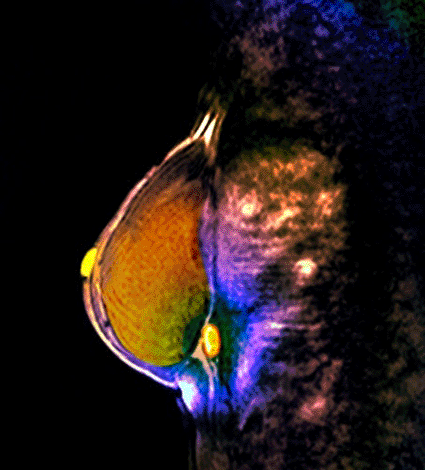New Imager Targets Small Breast Tumors
By MedImaging staff writers
Posted on 13 Feb 2008
Posted on 13 Feb 2008

Image: Colored magnetic resonance imaging (MRI) scan of the breast of a 50-year-old woman with breast cancer (Photo courtesy of Zephyr / SPL).
The results of initial testing of the positron emission mammography/positron emission tomography (PEM/PET) system, designed and constructed by scientists at the U.S. Department of Energy's (DOE) Thomas Jefferson National Accelerator Facility (Newport News, VA, USA), West Virginia University School of Medicine (WVU; Morgantown, USA), and the University of Maryland School of Medicine (Baltimore, USA), was published in the journal Physics in Medicine and Biology on February 7, 2008.
"This is the most important and most difficult imager we've developed so far,” said Dr. Stan Majewski, Jefferson Lab Radiation Detector and Medical Imaging Group leader. "It is another example of nuclear physics detector technology that we have put a lot of time and effort into adapting for the common good.”
Evaluation of the new imager was led by Dr. Ray Raylman, a professor of radiology and vice chair of radiology research at WVU and lead author on the study. Dr. Raylman's team imaged various radioactive sources to test the resolution of the system. "We had good performance characteristics, with image resolution below 2 mm. In regular PET, the image resolution is over 5 mm, so we're quite a bit better than that,” Dr. Raylman said.
Furthermore, the initial tests revealed that the PEM/PET system could complete an image and biopsy in about the same amount of time as a traditional biopsy. "The ability of the device to do biopsy is probably one of its most unique characteristics. There are other breast imagers, but none that are built specifically to do biopsy as well as imaging,” Dr. Raylman said.
The system features components designed for imaging the unique contours of the breast. Known as PEM, this imaging capability enables users to attain high-resolution, three-dimensional PET images of the breast. The PEM/PET system images the breast with a movable array of two pairs of two flat detection heads.
If a suspected lesion is found, a single pair of heads is then used to guide a needle biopsy to the lesion; the biopsy is performed with a human-controlled robot arm. Dr. Raylman is the inventor of the concept and has a patent on this device. The system is particularly useful in imaging tumors in women who have indeterminate mammograms because of dense or fibroglandular breasts.
The Jefferson Lab Radiation Detector and Medical Imaging Group, with a group member now affiliated with the University of Maryland School of Medicine, developed the detector heads with the on-board electronics, the data acquisition readout, and the image reconstruction software. The imaging device's gantry, and the motion-control software were developed by West Virginia University researchers.
The next steps for the team include minor improvements in the detector systems and image reconstruction software, and the addition of components for taking X-ray computed tomography (CT) scans. Initial clinical trials are planned after completion of systems testing.
Related Links:
Thomas Jefferson National Accelerator Facility
West Virginia University School of Medicine
University of Maryland School of Medicine













